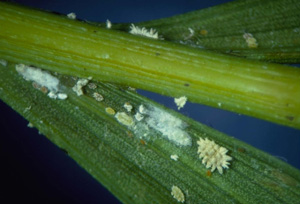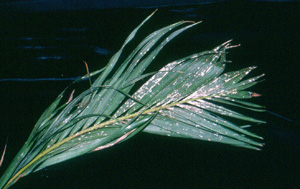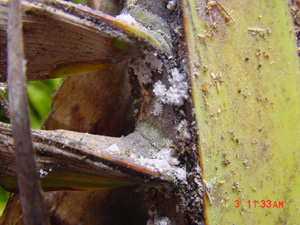Mealybug
Click on images to enlarge.
Coconut mealybug
Photo: Brian Bushe, CTAHR

Coconut mealybug
Photo: Brian Bushe, CTAHR

Coconut mealybug on palm
Photo: Dr. Arnold Hara, CTAHR
Problem
Your plants have white, cottony masses on the leaves and branches. Leaves are covered with a black, velvety substance and when you look closely you see ants. If the population of mealybugs is high enough, it can cause leaves and fruit to drop, slow growth of the plant, and cause twig dieback.
Description
Mealybugs are wingless, grayish white insects with soft bodies. They are segmented and have waxy filaments radiating from the body. They are called mealybugs because of a mealy or cottony wax which covers their bodies.
Information
- CTAHR Crop knowledge Master: Mealybugs
- UC Davis IPM Online: Mealybugs
- UC Davis IPM Online: species identification (does not cover all species found in Hawaii)
Control
Generally, light infestations of mealybugs are not harmful to plants. Healthy plants can withstand insect attack to a certain degree, so your first defense should be supporting vigorous plants with proper nutrition, light and watering. Do not use broad spectrum insecticides on your plants as these will kill naturally occurring predators, making your problem worse.
We recommend use of insecticidal soap or soft bodied insect spray (see below). You can also try simply spraying the insects off of the plant with a strong spray of water.
Soft Bodied Insect Spray Recipe:
(controls aphids, mealybugs, whiteflies, scales, citrus black flies)
Begin by preparing a stock solution of Soap-Oil Concentrate:
- Combine 1 Tablespoon of mild dishwashing liquid (Ivory, Joy or Dr. Bronner’s, NOT ultra formulas like Dawn) with
- 1 Cup of vegetable oil (peanut, safflower, corn, soybean, sunflower oil)
How to use the Soap-Oil Concentrate:
- Shake the solution of Soap-Oil Concentrate very well before use
- Dilute with water by mixing 1-2 teaspoons of concentrate into 1 cup of tap water.
- Spray plants thoroughly in the morning or late afternoon, especially the undersides of leaves
- Spray once a week for 2 or 3 weeks to eliminate the insects.
Source: Agricultural Research Service/November 1992
Kendal Lyon, Hawaii Island Master Gardeners


